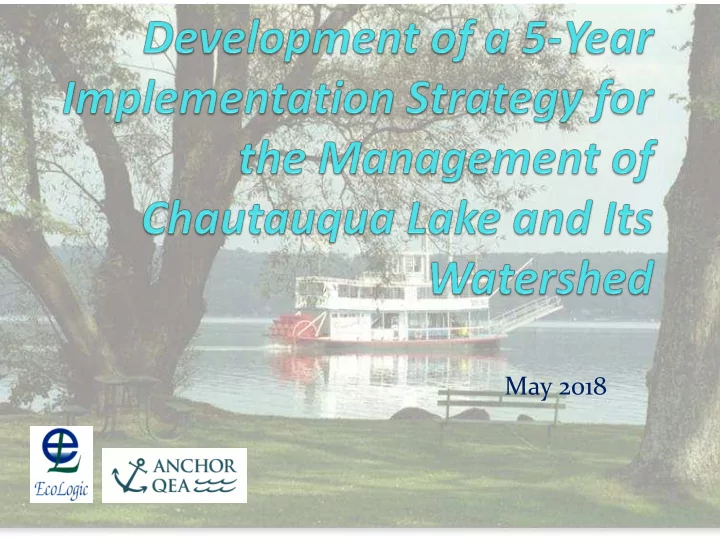

May 2018
Presentation Outline Overview of our assignment Draft Report – major findings Tiered application of the Decision Support Tool Major comments and revisions to Draft Report Looking ahead to implementation 2
Alliance Mission Knowledge of Stakeholder Lake and desires and watershed concerns management Funding Opportunities Priority Actions 3
Local Voices: Priorities Human health concerns Protect recreational access- economic driver Need for collaboration and coordination Fear that lake has reached a tipping point Need to document and communicate progress 4
Multi-criteria Analysis (MCA) Set up an evaluation matrix (project alternatives and evaluation criteria) Assign weighting factors to each criterion Indicates relative importance compared with other criteria Assign scores for ‘desirability’ under each criterion for each alternative 5
Criteria Common Watershed In-lake Scoring 6
Criteria: All Projects Consistent with plans, strategies, or successes Broadly supported Costs are understood Magnitude of costs Potential for outside funding Plan to measure and report effectiveness 7
Criteria: Watershed Projects Reduction in nutrient loading Reduction in sediment loading Hydrologic resilience 8
Criteria: In-lake Projects Protective of human health Protective of ecosystem health Longevity of effectiveness Reduce nutrients in ecosystem Manage invasive species Enhance recreational uses 9
Scoring Scaled as 0,3,6,9 Specific guidelines Potential role for scientific advisors for technical scoring 10
Application Define the project Document assumptions Determine whether to include all criteria Assign scores for criteria Matrix math to multiply weights; add and total Use totals as a guide to implementation Build partnerships with land owners Justify and request non-local cost sharing 11
Tiered Application of Tool Three levels: Tiers 1, 2, and 3 Increasing level of detail and specificity Began working with foundations to test-drive tool 12
Comment TMDL is widely acknowledged to be an estimate. Is it reasonable to use it to set priorities? Models are estimates Uncertainties abound, especially internal loading Data gaps: stream monitoring and profile sampling Precision Conservation approach 13
Comment Sediment load should be uncoupled from TMDL Agree Modified scoring criteria for projects designed to reduce erosion and sedimentation Referenced standard percent reductions from best management practices 14
Comment Too much emphasis on nutrient inactivation Prescient, based on NYSDEC progress Kept recommendation to estimate internal loading Added hypolimnetic oxygenation Expanded discussion of dredging (and arsenic) 15
Comment Who decides about scores ? Added external references- e.g., USEPA classification of chemical toxicity Retained suggestion of suggested role for Alliance’s science advisors 16
Comment Figure 5-1 Resource Allocation, 2018-2022 In-Lake Watershed Monitoring 2018 30% 50% 20% 2019 40% 40% 20% 2020 50% 30% 20% 2021 60% 20% 20% 2022 60% 20% 20% 17
Proportional Allocation Comments from all perspectives Did not change Important to remain flexible- adapt to opportunities Monitoring- address significant data gaps, provide a basis for adaptive management Encourage all projects to define and measure success 18
Year Watershed In-Lake 2018 Agricultural BMPs: buffers, cover crops, contour Mechanical harvesting strip-cropping (depending on land owner Enhanced shoreline cleanup participation) Herbicide treatment (per MMS) Green infrastructure for stormwater management Detailed monitoring to assess internal Municipal code enforcement phosphorus load Watershed pollution prevention education Sediment geochemical testing Data compilation and land-use files (such as LiDAR and subsequent analysis) for subwatersheds to prepare for modeling 2019 Agricultural BMPs: buffers, cover crops, contour Mechanical harvesting strip-cropping (depending on land owner Enhanced shoreline cleanup participation) Herbicide treatment (per MMS) Municipal stormwater Detailed monitoring to support EIS and Forestry practice inventory permitting for nutrient inactivation program or Watershed pollution prevention education hypolimnetic oxygenation, if warranted based on 2018 results Stream monitoring SWAT model (or similar) 2020 BMPs as guided by watershed model projections Mechanical harvesting Stream monitoring: before and after BMPs Enhanced shoreline cleanup Herbicide treatment (per MMS) Effectiveness of nutrient inactivation (if implemented) 2021 BMPs as guided by watershed model projections Mechanical harvesting Stream monitoring: before and after BMPs Enhanced shoreline cleanup Herbicide treatment (per MMS) Effectiveness of nutrient inactivation (if implemented) 2022 BMPs as guided by watershed model projections Mechanical harvesting Stream monitoring: before and after BMPs Enhanced shoreline cleanup Herbicide treatment (per MMS) Effectiveness of nutrient inactivation (if implemented) 19
Recommend
More recommend